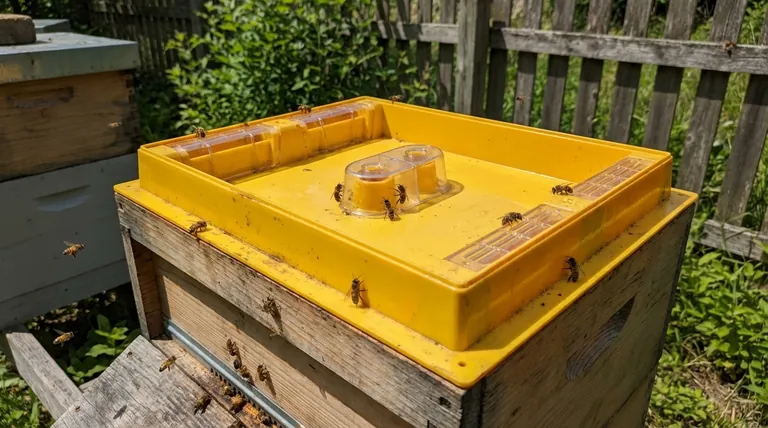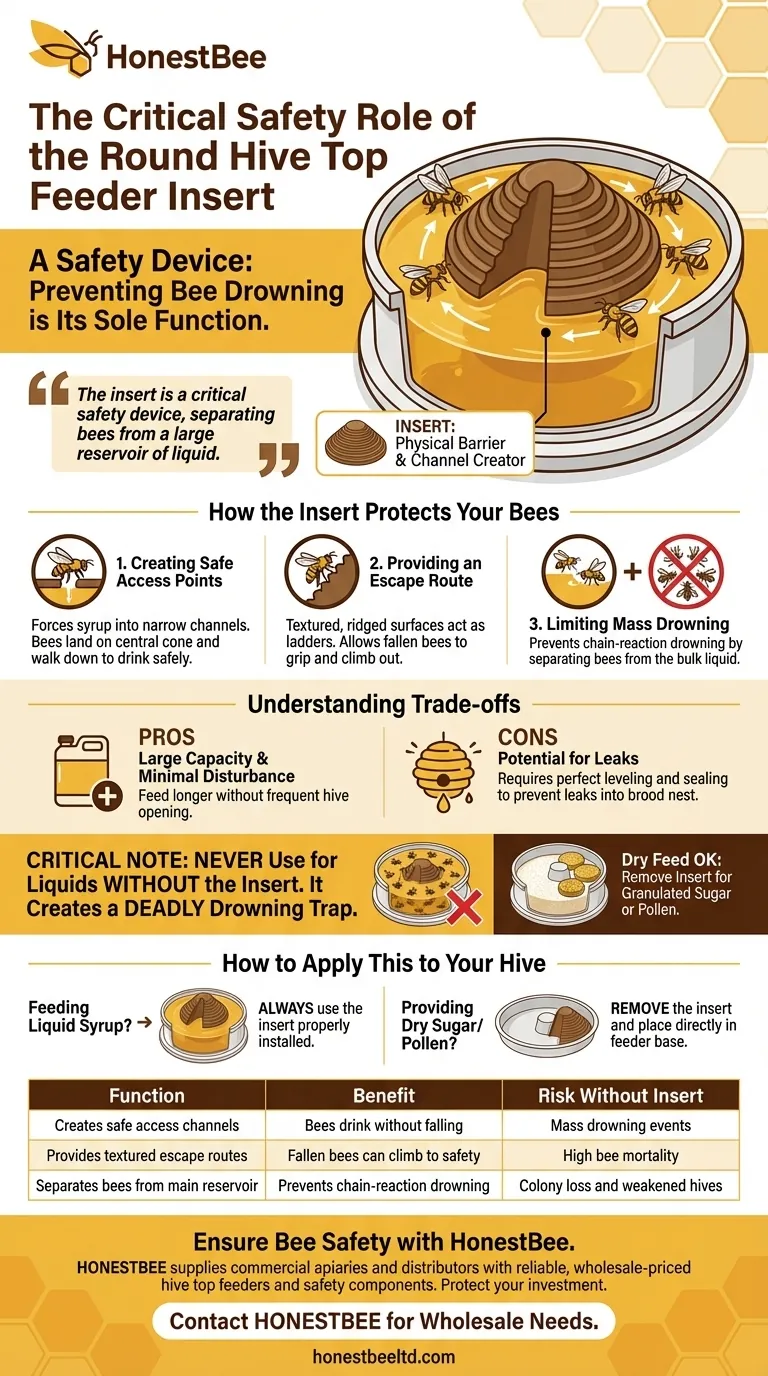The insert in a round hive top feeder is a critical safety device. Its sole function is to prevent your bees from drowning in the liquid syrup you are providing. It creates a physical barrier and a series of channels that allow bees to access the feed without falling into a large, open reservoir of liquid.
While a hive top feeder is designed for convenience, its core component—the insert—is designed for bee safety. Understanding its function is essential for preventing accidental colony loss during feeding.

How the Insert Protects Your Bees
A large, open container of sugar syrup is one of the most dangerous things you can place in a beehive. Bees are attracted to the liquid but are poor swimmers. The insert mitigates this risk through several key design features.
Creating Safe Access Points
The insert, typically a plastic cone or ridged cup, sits in the center of the feeder. This design forces the syrup into a narrow channel around the perimeter, preventing bees from accessing a wide, deep pool of liquid.
Bees can land on the central cone and walk down its sides to drink safely from the channel.
Providing an Escape Route
The surfaces of the insert are intentionally textured or molded with ridges. These act as ladders.
If a bee accidentally falls into the syrup, these textured surfaces give it something to grip, allowing it to climb out and avoid drowning. Without the insert, the smooth, slick walls of the feeder offer no escape.
Limiting Mass Drowning Events
In an open feeder, if one bee falls in and struggles, others may be attracted to the commotion and also fall in. This can create a chain reaction, resulting in a large mat of dead bees.
By separating the bees from the bulk of the liquid, the insert makes such a mass drowning event virtually impossible.
Understanding the Trade-offs of Top Feeders
While effective, hive top feeders require correct use to be beneficial. Understanding their operational quirks is key to successful feeding.
Pro: Large Capacity and Minimal Disturbance
Hive top feeders hold a significant amount of syrup, often a gallon or more. This means you can feed the colony for a longer period without having to open the hive and disturb the bees as frequently.
Con: Potential for Leaks
These feeders rely on a tight seal with the top of the hive. If your hive is not perfectly level, or if the cover is not placed correctly, syrup can leak down into the brood nest. This can drown bees, chill brood, and incite robbing from other hives.
Critical Note: Never Use for Liquids Without the Insert
The single biggest mistake a beekeeper can make with this equipment is attempting to feed liquid syrup without the insert. Doing so creates a deadly drowning trap for your bees.
The feeder can, however, be used for dry feed (like granulated sugar or pollen patties) by removing the insert entirely.
How to Apply This to Your Hive
Your feeding strategy dictates how you use the feeder and its components.
- If your primary focus is feeding liquid syrup: Always use the feeder with the central insert properly installed to ensure bee safety.
- If your primary focus is providing dry sugar or pollen: Remove the insert and place the dry material directly in the feeder's base.
Properly using your equipment is the foundation of responsible and effective hive management.
Summary Table:
| Function | Benefit | Risk Without Insert |
|---|---|---|
| Creates safe access channels | Bees can drink without falling into syrup | Mass drowning events |
| Provides textured escape routes | Fallen bees can climb to safety | High bee mortality |
| Separates bees from the main reservoir | Prevents chain-reaction drowning | Colony loss and weakened hives |
Ensure the safety and health of your bees with the right equipment. HONESTBEE supplies commercial apiaries and beekeeping equipment distributors with reliable, wholesale-priced hive top feeders and essential safety components. Our products are designed to support effective hive management and prevent costly losses. Contact HONESTBEE today to discuss your wholesale needs and protect your investment.
Visual Guide

Related Products
- Professional Hive Top Bee Feeder for Beekeeping
- HONESTBEE Round Hive Top Bee Feeder for Syrup
- HONESTBEE Professional Hive Top Bee Feeder Feeding Solution
- Classic Boardman Entrance Bee Feeder Hive Front Feeding Solution
- Boardman Entrance Bee Feeder Durable Galvanized Steel and Wood Construction for Beekeeping
People Also Ask
- What types of hive boxes is the round hive top feeder compatible with? Universal Fit for 8 & 10-Frame Langstroth Hives
- Do I need an inner cover with a hive top feeder? Optimize Your Hive Setup for Healthy Bees
- What is the best bee feeder for a hive? Choose the Right Feeder for Your Apiary's Scale
- How is the plywood floor fitted into the hive-top feeder? Ensure Longevity with a Floating Floor Design
- What are the features of top feeders for bees? Maximize Hive Health with Safe, High-Capacity Feeding



















